
Laboratory glassware refers to a variety of equipment used in scientific work, and traditionally made of glass. Glass can be blown, bent, cut, molded, and formed into many sizes and shapes, and is therefore common in chemistry, biology, and analytical laboratories. Many laboratories have training programs to demonstrate how glassware is used and to alert first–time users to the safety hazards involved with using glassware.

A dishwasher is a machine that is used to clean dishware, cookware, and cutlery automatically. Unlike manual dishwashing, which relies on physical scrubbing to remove soiling, the mechanical dishwasher cleans by spraying hot water, typically between 45 and 75 °C, at the dishes, with lower temperatures of water used for delicate items.
Rack or racks may refer to:
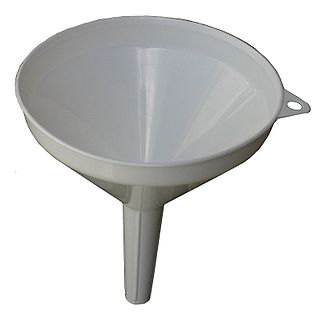
A funnel is a tube or pipe that is wide at the top and narrow at the bottom, used for guiding liquid or powder into a small opening.

A stopper, bung, or cork is a cylindrical or conical closure used to seal a container, such as a bottle, tube, or barrel.

A Büchner funnel is a piece of laboratory equipment used in filtration. It is traditionally made of porcelain, but glass and plastic funnels are also available. On top of the funnel-shaped part there is a cylinder with a fritted glass disc/perforated plate separating it from the funnel. The Hirsch funnel has a similar design; it is used similarly, but for smaller quantities of material. The main difference is that the plate of a Hirsch funnel is much smaller, and the walls of the funnel angle outward instead of being vertical.
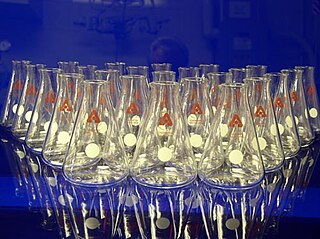
Laboratory flasks are vessels or containers that fall into the category of laboratory equipment known as glassware. In laboratory and other scientific settings, they are usually referred to simply as flasks. Flasks come in a number of shapes and a wide range of sizes, but a common distinguishing aspect in their shapes is a wider vessel "body" and one narrower tubular sections at the top called necks which have an opening at the top. Laboratory flask sizes are specified by the volume they can hold, typically in metric units such as milliliters or liters. Laboratory flasks have traditionally been made of glass, but can also be made of plastic.
A thistle tube is a piece of laboratory glassware consisting of a shaft of tube, with a reservoir and funnel-like section at the top. Thistle tubes are typically used by chemists to add liquid to an existing system or apparatus. Thistle funnels are used to add small volumes of liquids to an exact position. Thistle funnels are found with or without taps.
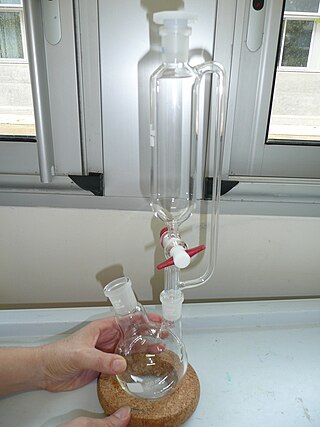
A dropping funnel or addition funnel is a type of laboratory glassware used to transfer liquids. They are fitted with a stopcock which allows the flow to be controlled. Dropping funnels are useful for adding reagents slowly, i.e. drop-wise. This is desirable when the quick addition of the reagent results in side reactions, or if the reaction is too vigorous.

A countertop, also counter top, counter, benchtop, worktop or kitchen bench, bunker is a raised, firm, flat, and horizontal surface. They are built for work in kitchens or other food preparation areas, bathrooms or lavatories, and workrooms in general. The surface is frequently installed upon and supported by cabinets, positioned at an ergonomic height for the user and the particular task for which it is designed. A countertop may be constructed of various materials with different attributes of functionality, durability and aesthetics, and may have built-in appliances, or accessory items relative to the intended application.
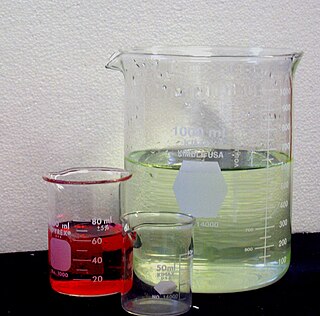
In laboratory equipment, a beaker is generally a cylindrical container with a flat bottom. Most also have a small spout to aid pouring, as shown in the picture. Beakers are available in a wide range of sizes, from one milliliter up to several liters. A beaker is distinguished from a flask by having straight rather than sloping sides. The exception to this definition is a slightly conical-sided beaker called a Philips beaker. The beaker shape in general drinkware is similar.

Round-bottom flasks are types of flasks having spherical bottoms used as laboratory glassware, mostly for chemical or biochemical work. They are typically made of glass for chemical inertness; and in modern days, they are usually made of heat-resistant borosilicate glass. There is at least one tubular section known as the neck with an opening at the tip. Two- or three-necked flasks are common as well. Round bottom flasks come in many sizes, from 5 mL to 20 L, with the sizes usually inscribed on the glass. In pilot plants even larger flasks are encountered.
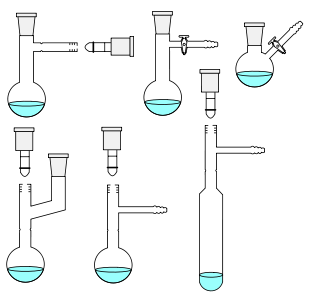
A Schlenk flask, or Schlenk tube, is a reaction vessel typically used in air-sensitive chemistry, invented by Wilhelm Schlenk. It has a side arm fitted with a PTFE or ground glass stopcock, which allows the vessel to be evacuated or filled with gases. These flasks are often connected to Schlenk lines, which allow both operations to be done easily.

Ground glass joints are used in laboratories to quickly and easily fit leak-tight apparatus together from interchangeable commonly available parts. For example, a round bottom flask, Liebig condenser, and oil bubbler with ground glass joints may be rapidly fitted together to reflux a reaction mixture. This is a large improvement compared with older methods of custom-made glassware, which was time-consuming and expensive, or the use of less chemical resistant and heat resistant corks or rubber bungs and glass tubes as joints, which took time to prepare as well.

A policeman is a hand-held flexible natural-rubber or plastic scraper. The common type of it is attached to a glass rod and used in chemical laboratories to transfer residues of precipitate or solid on glass surfaces when performing gravimetric analysis. This equipment works well under gentle, delicate and precise requirement. A policeman also comes in various sizes, shapes, and types. Some of them come in one-piece flexible plastic version and some in stainless. The origin of the policeman and its name cannot be identified for sure but some clues led back to the 19th century from German chemist Carl Remigius Fresenius.

A media dispenser or a culture media dispenser is a device for repeatedly delivering small fixed volumes of liquid such as a laboratory growth medium like molten agar or caustic or volatile solvents like toluene into a series of receptacles. It is often important that such dispensers operate without biological or chemical contamination, and so must be internally sealed from the environment and designed for easy cleaning and sterilization before use. At a minimum, a media dispenser consists of some kind of pump connected to a length of discharge tubing or a spout. Dispensers used in laboratories are also frequently connected to microcontrollers to regulate the speed and volume of the medium as it leaves the pump.

Test tube racks are laboratory equipment used to hold upright multiple test tubes at the same time. They are most commonly used when various different solutions are needed to work with simultaneously, for safety reasons, for safe storage of test tubes, and to ease the transport of multiple tubes. Test tube racks also ease the organization of test tubes and provide support for the test tubes being worked with.

Crucible tongs are scissors-like tools with a pair of attached arms that curve outward near the ends to form a rounded gripping area that allows users to safely grasp crucibles, flasks, evaporating dishes, or small beakers. They are made of durable metals—stainless steel, brass, or nickel, for example—that can withstand high temperatures.
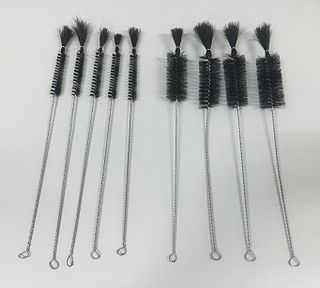
A test tube brush or spout brush is a brush used for cleaning test tubes and narrow mouth laboratory glassware, such as graduated cylinders, burettes, and Erlenmeyer flasks. It is composed of nylon, synthetic, or animal fur bristles of various diameters lined against a rather sturdy wire handle with a looped end for hanging. The wire can be made from a wide range of metals, such as aluminium, bronze, beryllium, copper, and brass. FDA grade brushes are designed to be resistant to acid and other corrosive chemicals, including aromatic and aliphatic hydrocarbons, ketones, ethyl acetate esters, and trichloroethylene.
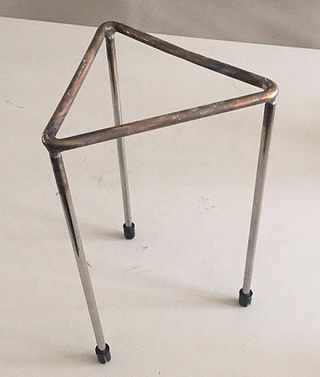
A laboratory tripod is a three-legged platform used to support flasks and beakers. Tripods are usually made of stainless steel or aluminium and made light-weight for efficient portability within the lab. Often a wire gauze is placed on top of the tripod to provide a flat base for glassware. Tripods are generally tall enough for a bunsen burner to be placed underneath.


























